Spring Cloud Alibaba之服务容错组件 - Sentinel [规则持久化篇]
Posted
tags:
篇首语:本文由小常识网(cha138.com)小编为大家整理,主要介绍了Spring Cloud Alibaba之服务容错组件 - Sentinel [规则持久化篇]相关的知识,希望对你有一定的参考价值。
规则持久化 - 拉模式在Sentinel控制台对某个微服务的接口资源配置了流控、降级等规则后,若重启了该微服务,那么配置的相关规则就会丢失,因为Sentinel默认将规则存放在内存中。每次重启微服务都得重新配置规则显然是不合理的,所以我们需要将配置好的规则进行持久化存储,而Sentinel提供了两种规则持久化模式:
- 拉模式(pull)
- 推模式(push)
本小节先介绍一下拉模式(pull),该模式的架构图如下:
- Tips:规则在代码中实际上是一个对象,所以通常是转换成json字符串后再存储至本地文件
因为需要读写本地文件,所以实现拉模式需要编写一些代码,首先在项目中添加如下依赖:
<!-- Sentinel Datasource -->
<dependency>
<groupId>com.alibaba.csp</groupId>
<artifactId>sentinel-datasource-extension</artifactId>
</dependency>由于Sentinel有好几种规则,所以需要写的代码也有点多,具体代码如下示例:
package com.zj.node.contentcenter.sentinel;
import com.alibaba.csp.sentinel.command.handler.ModifyParamFlowRulesCommandHandler;
import com.alibaba.csp.sentinel.datasource.*;
import com.alibaba.csp.sentinel.init.InitFunc;
import com.alibaba.csp.sentinel.slots.block.authority.AuthorityRule;
import com.alibaba.csp.sentinel.slots.block.authority.AuthorityRuleManager;
import com.alibaba.csp.sentinel.slots.block.degrade.DegradeRule;
import com.alibaba.csp.sentinel.slots.block.degrade.DegradeRuleManager;
import com.alibaba.csp.sentinel.slots.block.flow.FlowRule;
import com.alibaba.csp.sentinel.slots.block.flow.FlowRuleManager;
import com.alibaba.csp.sentinel.slots.block.flow.param.ParamFlowRule;
import com.alibaba.csp.sentinel.slots.block.flow.param.ParamFlowRuleManager;
import com.alibaba.csp.sentinel.slots.system.SystemRule;
import com.alibaba.csp.sentinel.slots.system.SystemRuleManager;
import com.alibaba.csp.sentinel.transport.util.WritableDataSourceRegistry;
import com.alibaba.fastjson.JSON;
import com.alibaba.fastjson.TypeReference;
import lombok.extern.slf4j.Slf4j;
import java.io.File;
import java.io.FileNotFoundException;
import java.io.IOException;
import java.util.List;
/**
* 规则持久化 - 拉模式
*
* @author 01
* @date 2019-08-02
**/
@Slf4j
public class FileDataSourceInitial implements InitFunc
/**
* 定义并实现各个规则对象的转换器,用于将json格式的数据转换为相应的Java对象
*/
private Converter<String, List<FlowRule>> flowRuleListParser = source -> JSON.parseObject(
source,
new TypeReference<List<FlowRule>>()
);
private Converter<String, List<DegradeRule>> degradeRuleListParser = source -> JSON.parseObject(
source,
new TypeReference<List<DegradeRule>>()
);
private Converter<String, List<SystemRule>> systemRuleListParser = source -> JSON.parseObject(
source,
new TypeReference<List<SystemRule>>()
);
private Converter<String, List<AuthorityRule>> authorityRuleListParser = source -> JSON.parseObject(
source,
new TypeReference<List<AuthorityRule>>()
);
private Converter<String, List<ParamFlowRule>> paramFlowRuleListParser = source -> JSON.parseObject(
source,
new TypeReference<List<ParamFlowRule>>()
);
@Override
public void init() throws Exception
// 规则持久化文件所存放的路径及文件名,可以按需求自行修改
String ruleDir = System.getProperty("user.home") + "/sentinel/rules";
String flowRulePath = ruleDir + "/flow-rule.json";
String degradeRulePath = ruleDir + "/degrade-rule.json";
String systemRulePath = ruleDir + "/system-rule.json";
String authorityRulePath = ruleDir + "/authority-rule.json";
String paramFlowRulePath = ruleDir + "/param-flow-rule.json";
// 目录路径及文件若不存在则创建
this.mkdirIfNotExits(ruleDir);
this.createFileIfNotExits(flowRulePath);
this.createFileIfNotExits(degradeRulePath);
this.createFileIfNotExits(systemRulePath);
this.createFileIfNotExits(authorityRulePath);
this.createFileIfNotExits(paramFlowRulePath);
// 注册各个规则的可读写数据源
this.registerFlowRWDS(flowRulePath);
this.registerDegradeRWDS(degradeRulePath);
this.registerSystemRWDS(systemRulePath);
this.registerAuthorityRWDS(authorityRulePath);
this.registerParamRWDS(paramFlowRulePath);
/**
* 注册流控规则的可读写数据源
*/
private void registerFlowRWDS(String flowRulePath) throws FileNotFoundException
// 构建可读数据源,用于定时读取本地的json文件
ReadableDataSource<String, List<FlowRule>> flowRuleRDS = new FileRefreshableDataSource<>(
flowRulePath,
flowRuleListParser
);
// 将可读数据源注册至FlowRuleManager,当文件里的规则内容发生变化时,就会更新到缓存里
FlowRuleManager.register2Property(flowRuleRDS.getProperty());
// 构建可写数据源
WritableDataSource<List<FlowRule>> flowRuleWDS = new FileWritableDataSource<>(
flowRulePath,
this::toJson
);
// 将可写数据源注册至transport模块的WritableDataSourceRegistry中
// 这样收到控制台推送的规则时,Sentinel会先更新到内存,然后将规则写入到文件中
WritableDataSourceRegistry.registerFlowDataSource(flowRuleWDS);
/**
* 注册降级规则的可读写数据源
*/
private void registerDegradeRWDS(String degradeRulePath) throws FileNotFoundException
ReadableDataSource<String, List<DegradeRule>> degradeRuleRDS = new FileRefreshableDataSource<>(
degradeRulePath,
degradeRuleListParser
);
DegradeRuleManager.register2Property(degradeRuleRDS.getProperty());
WritableDataSource<List<DegradeRule>> degradeRuleWDS = new FileWritableDataSource<>(
degradeRulePath,
this::toJson
);
WritableDataSourceRegistry.registerDegradeDataSource(degradeRuleWDS);
/**
* 注册系统规则的可读写数据源
*/
private void registerSystemRWDS(String systemRulePath) throws FileNotFoundException
ReadableDataSource<String, List<SystemRule>> systemRuleRDS = new FileRefreshableDataSource<>(
systemRulePath,
systemRuleListParser
);
SystemRuleManager.register2Property(systemRuleRDS.getProperty());
WritableDataSource<List<SystemRule>> systemRuleWDS = new FileWritableDataSource<>(
systemRulePath,
this::toJson
);
WritableDataSourceRegistry.registerSystemDataSource(systemRuleWDS);
/**
* 注册授权规则的可读写数据源
*/
private void registerAuthorityRWDS(String authorityRulePath) throws FileNotFoundException
ReadableDataSource<String, List<AuthorityRule>> authorityRuleRDS = new FileRefreshableDataSource<>(
authorityRulePath,
authorityRuleListParser
);
AuthorityRuleManager.register2Property(authorityRuleRDS.getProperty());
WritableDataSource<List<AuthorityRule>> authorityRuleWDS = new FileWritableDataSource<>(
authorityRulePath,
this::toJson
);
WritableDataSourceRegistry.registerAuthorityDataSource(authorityRuleWDS);
/**
* 注册热点参数规则的可读写数据源
*/
private void registerParamRWDS(String paramFlowRulePath) throws FileNotFoundException
ReadableDataSource<String, List<ParamFlowRule>> paramFlowRuleRDS = new FileRefreshableDataSource<>(
paramFlowRulePath,
paramFlowRuleListParser
);
ParamFlowRuleManager.register2Property(paramFlowRuleRDS.getProperty());
WritableDataSource<List<ParamFlowRule>> paramFlowRuleWDS = new FileWritableDataSource<>(
paramFlowRulePath,
this::toJson
);
ModifyParamFlowRulesCommandHandler.setWritableDataSource(paramFlowRuleWDS);
private void mkdirIfNotExits(String filePath)
File file = new File(filePath);
if (!file.exists())
boolean result = file.mkdirs();
log.info("创建目录: filePath: ", result ? "成功" : "失败", filePath);
private void createFileIfNotExits(String filePath) throws IOException
File file = new File(filePath);
if (!file.exists())
boolean result = file.createNewFile();
log.info("创建文件: filePath: ", result ? "成功" : "失败", filePath);
private <T> String toJson(T t)
return JSON.toJSONString(t);
这里有两个重要的API:
FileRefreshableDataSource定时从指定文件中读取规则JSON文件【上图中的本地文件】,如果发现文件发生变化,就更新规则缓存FileWritableDataSource接收控制台规则推送,并根据配置,修改规则JSON文件【上图中的本地文件】
编写完以上代码后,还需要在项目的 resources/META-INF/services 目录下创建一个文件,名为 com.alibaba.csp.sentinel.init.InitFunc ,如下图所示: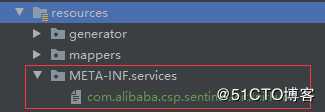
然后编辑文件内容如下:
# 修改为上面FileDataSourceInitial的包名类名全路径
com.zj.node.contentcenter.sentinel.FileDataSourceInitial完成以上步骤后,重启项目,此时就可以自行测试一下规则是否能持久化存储了。
拉模式的优缺点:
- 优点:
- 简单易懂,没有多余依赖(如配置中心、缓存等依赖)
- 缺点:
- 由于规则是用 FileRefreshableDataSource 定时更新的,所以规则更新会有延迟。如果FileRefreshableDataSource定时时间过大,可能长时间延迟;如果FileRefreshableDataSource过小,又会影响性能
- 规则存储在本地文件,如果有一天需要迁移微服务,那么需要把规则文件一起迁移,否则规则会丢失
如果有了解过规则持久化相关配置的小伙伴可能会有疑问,Spring Cloud Alibaba不是提供了如下配置了吗?为什么要全部自己写呢?
spring.cloud.sentinel.datasource.ds1.file.file=classpath: degraderule.json
spring.cloud.sentinel.datasource.ds1.file.rule-type=flow
#spring.cloud.sentinel.datasource.ds1.file.file=classpath: flowrule.json
#spring.cloud.sentinel.datasource.ds1.file.data-type=custom
#spring.cloud.sentinel.datasource.ds1.file.converter-class=com.alibaba.cloud.examples.JsonFlowRuleListConverter
#spring.cloud.sentinel.datasource.ds1.file.rule-type=flow关于这个问题,可以查看一下这个Issues
官方文档:
规则持久化 - 推模式
在上一小节中,我们了解了规则持久化中拉模式的原理及使用方式,本小节将介绍在生产环境中更为常用的推模式(push)。
推模式的架构图如下: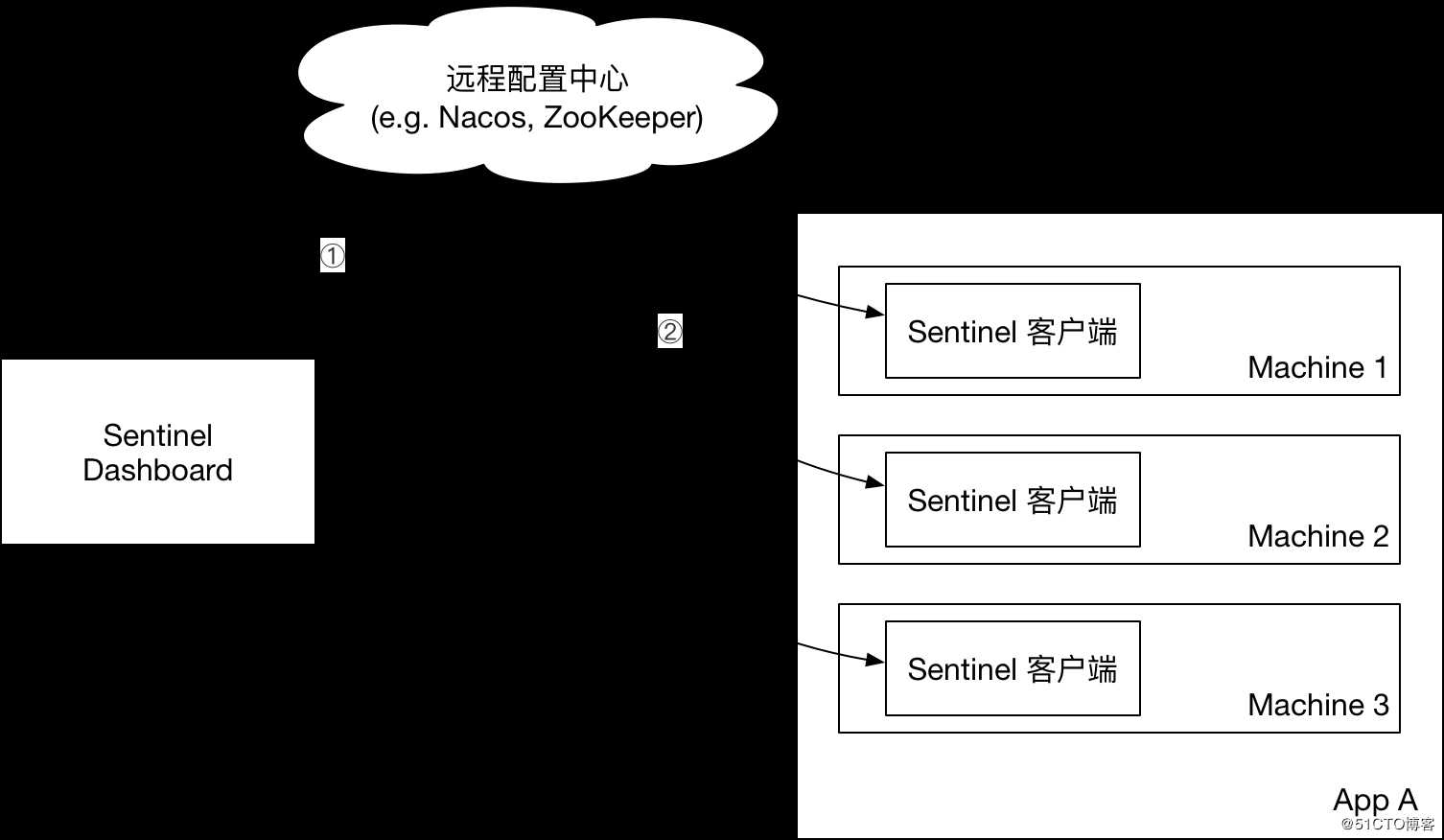
- Sentinel控制台不再是调用客户端的API推送规则数据,而是将规则推送到Nacos或其他远程配置中心
- Sentinel客户端通过连接Nacos,来获取规则配置;并监听Nacos配置变化,如发生变化,就更新本地缓存(从而让本地缓存总是和Nacos一致)
- Sentinel控制台也监听Nacos配置变化,如发生变化就更新本地缓存(从而让Sentinel控制台的本地缓存总是和Nacos一致)
改造Sentinel控制台
使用推模式进行规则的持久化还是稍微有些麻烦的,因为需要改动Sentinel控制台的源码,对控制台的改造主要是为了实现:
- DynamicRuleProvider:从Nacos上读取配置
- DynamicRulePublisher:将规则推送到Nacos上
这里仅演示对流控规则的改造让其支持推模式的规则持久化,因为其他规则的改造过程也是类似的,稍微琢磨一下就可以了。首先需要下载Sentinel的源码包,我这里使用的是1.6.3版本:
下载并解压完成后,使用IDE打开sentinel-dashboard这个项目,如下:
第一步:修改该项目的pom.xml文件,找到如下依赖项:
<!-- for Nacos rule publisher sample -->
<dependency>
<groupId>com.alibaba.csp</groupId>
<artifactId>sentinel-datasource-nacos</artifactId>
<scope>test</scope>
</dependency>将<scope>test</scope>一行注释掉,即修改为如下:
<!-- for Nacos rule publisher sample -->
<dependency>
<groupId>com.alibaba.csp</groupId>
<artifactId>sentinel-datasource-nacos</artifactId>
<!-- <scope>test</scope> -->
</dependency>第二步:找到 sentinel-dashboard/src/test/java/com/alibaba/csp/sentinel/dashboard/rule/nacos目录,将整个目录拷贝到 sentinel-dashboard/src/main/java/com/alibaba/csp/sentinel/dashboard/rule/nacos下,如下图所示:
拷贝完成后rule包结构如下图: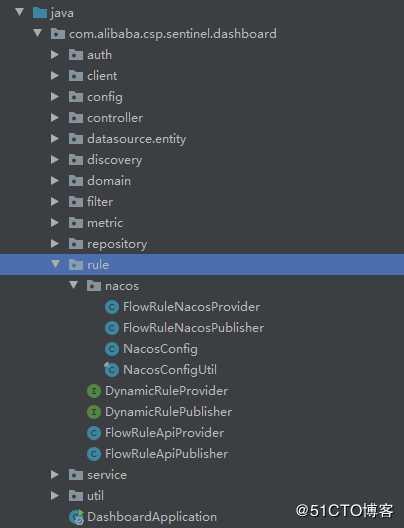
第三步:修改流控规则Controller,到com.alibaba.csp.sentinel.dashboard.controller.v2.FlowControllerV2类的源码中找到这一段:
@Autowired
@Qualifier("flowRuleDefaultProvider")
private DynamicRuleProvider<List<FlowRuleEntity>> ruleProvider;
@Autowired
@Qualifier("flowRuleDefaultPublisher")
private DynamicRulePublisher<List<FlowRuleEntity>> rulePublisher;修改@Qualifier注解的内容,将其修改为:
@Autowired
@Qualifier("flowRuleNacosProvider")
private DynamicRuleProvider<List<FlowRuleEntity>> ruleProvider;
@Autowired
@Qualifier("flowRuleNacosPublisher")
private DynamicRulePublisher<List<FlowRuleEntity>> rulePublisher;第四步:打开sentinel-dashboard/src/main/webapp/resources/app/scripts/directives/sidebar/sidebar.html文件,找到一段被注释的代码,如下:
<!--<li ui-sref-active="active" ng-if="entry.appType==0">-->
<!--<a ui-sref="dashboard.flow(app: entry.app)">-->
<!--<i class="glyphicon glyphicon-filter"></i> 流控规则 V1</a>-->
<!--</li>-->只需要把注释解开,即改为:
<li ui-sref-active="active" ng-if="entry.appType==0">
<a ui-sref="dashboard.flow(app: entry.app)">
<i class="glyphicon glyphicon-filter"></i> 流控规则 V1</a>
</li>到这步为止,我们就对sentinel-dashboard源码改造完毕了,现在流控规则就可以支持推模式的持久化了,接下来就是编译、启动以及测试。
打开idea的terminal,执行如下命令进行打包编译:
mvn clean package -DskipTests然后进入target目录,使用如下命令执行jar包,启动Sentinel控制台:
java -jar sentinel-dashboard.jar注:也可以选择直接在idea中点击启动按钮来启动Sentinel控制台,效果是一样的
启动完成后,使用浏览器打开,可以看到Sentinel的菜单栏中比之前多出了一项流控规则 V1: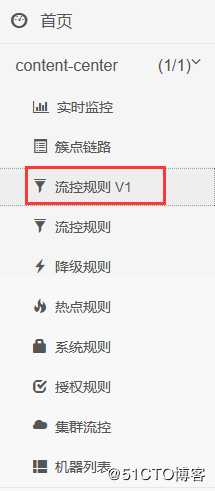
注:若没有显示该项,可以尝试清除浏览器缓存或换个浏览器打开
改造Sentinel客户端( 微服务)
改造完控制台后,接下来开始改造客户端,首先在项目中添加如下依赖:
<dependency>
<groupId>com.alibaba.csp</groupId>
<artifactId>sentinel-datasource-nacos</artifactId>
</dependency>然后添加各个规则配置:
spring:
cloud:
sentinel:
datasource:
# 名称随意
flow:
nacos:
server-addr: localhost:8848
dataId: $spring.application.name-flow-rules
groupId: SENTINEL_GROUP
# 规则类型,取值见:
# org.springframework.cloud.alibaba.sentinel.datasource.RuleType
rule-type: flow
degrade:
nacos:
server-addr: localhost:8848
dataId: $spring.application.name-degrade-rules
groupId: SENTINEL_GROUP
rule-type: degrade
system:
nacos:
server-addr: localhost:8848
dataId: $spring.application.name-system-rules
groupId: SENTINEL_GROUP
rule-type: system
authority:
nacos:
server-addr: localhost:8848
dataId: $spring.application.name-authority-rules
groupId: SENTINEL_GROUP
rule-type: authority
param-flow:
nacos:
server-addr: localhost:8848
dataId: $spring.application.name-param-flow-rules
groupId: SENTINEL_GROUP
rule-type: param-flow完成以上步骤后重启项目,然后回到Sentinel控制台里的流控规则 V1中新增流控规则,之所以不在簇点链路中添加,是因为簇点链路中的按钮依旧是调用之前的逻辑添加到内存中。新增流控规则如下: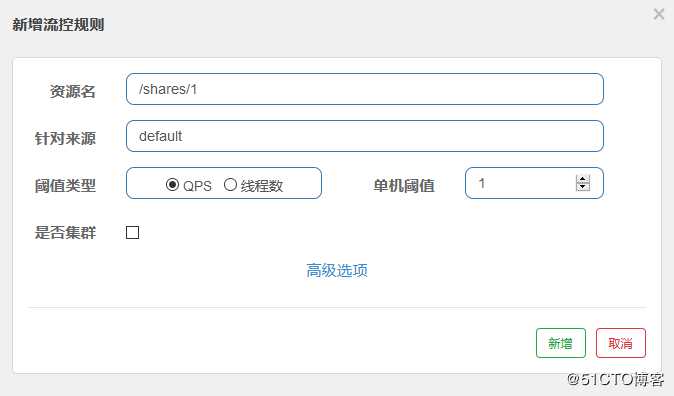
新增完成后,到Nacos Server的配置列表上,可以看到该规则的配置数据,证明已经持久化存储到Nacos了:
若直接在Nacos上修改流控规则,然后刷新Sentinel控制台,控制台上的显示也会被修改
此时重启Sentinel控制台和微服务,然后刷新控制台,可以发现该流控规则依旧存在:
以上折腾了那么多只实现了流控规则的持久化,这还是因为官方准备好了示例代码。Sentinel有若干种规则,例如降级规则、系统规则、授权规则、热点规则等,都需要使用类似的方式,修改 com.alibaba.csp.sentinel.dashboard.controller 包中对应的Controller,才能实现持久化,所以本小节仅是抛砖引玉,其他规则可以自行动手参考着实现。
推模式优缺点:
- 优点:
- 一致性良好,性能优秀,贴近生产使用
- 缺点:
- 需要对控制台的源码进行改动比较麻烦,并且所有规则加起来的改动工作量较大
- 引入额外的依赖(Nacos)
官方文档:
将应用接入阿里云 AHAS 服务
在生产环境使用Sentinel是必须要实现规则持久化的,而通过以上两个小节的学习,我们可以得知不管使用哪个模式都需要进行相应的改动,其中想要实现贴近生产使用的推模式需要改动的地方更多更麻烦。
如果不想做这些麻烦的改动,又希望在生产环境使用Sentinel的话,则需要考虑使用阿里云提供的在线托管Sentinel控制台(AHAS),该在线Sentinel控制台实现了推模式的规则持久化并可用于生产:
接下来演示一下如何使用这个在线的Sentinel控制台,根据开通说明文档注册了阿里云账户后,进入开通页面: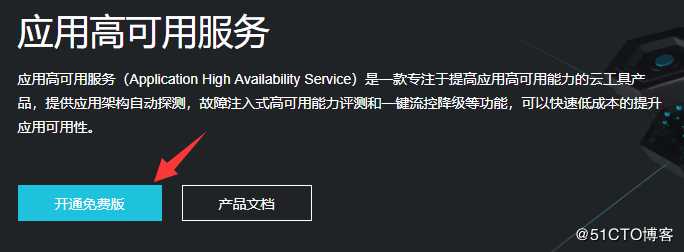
根据提示开通完成后,进入管理控制台,点击接入应用流控: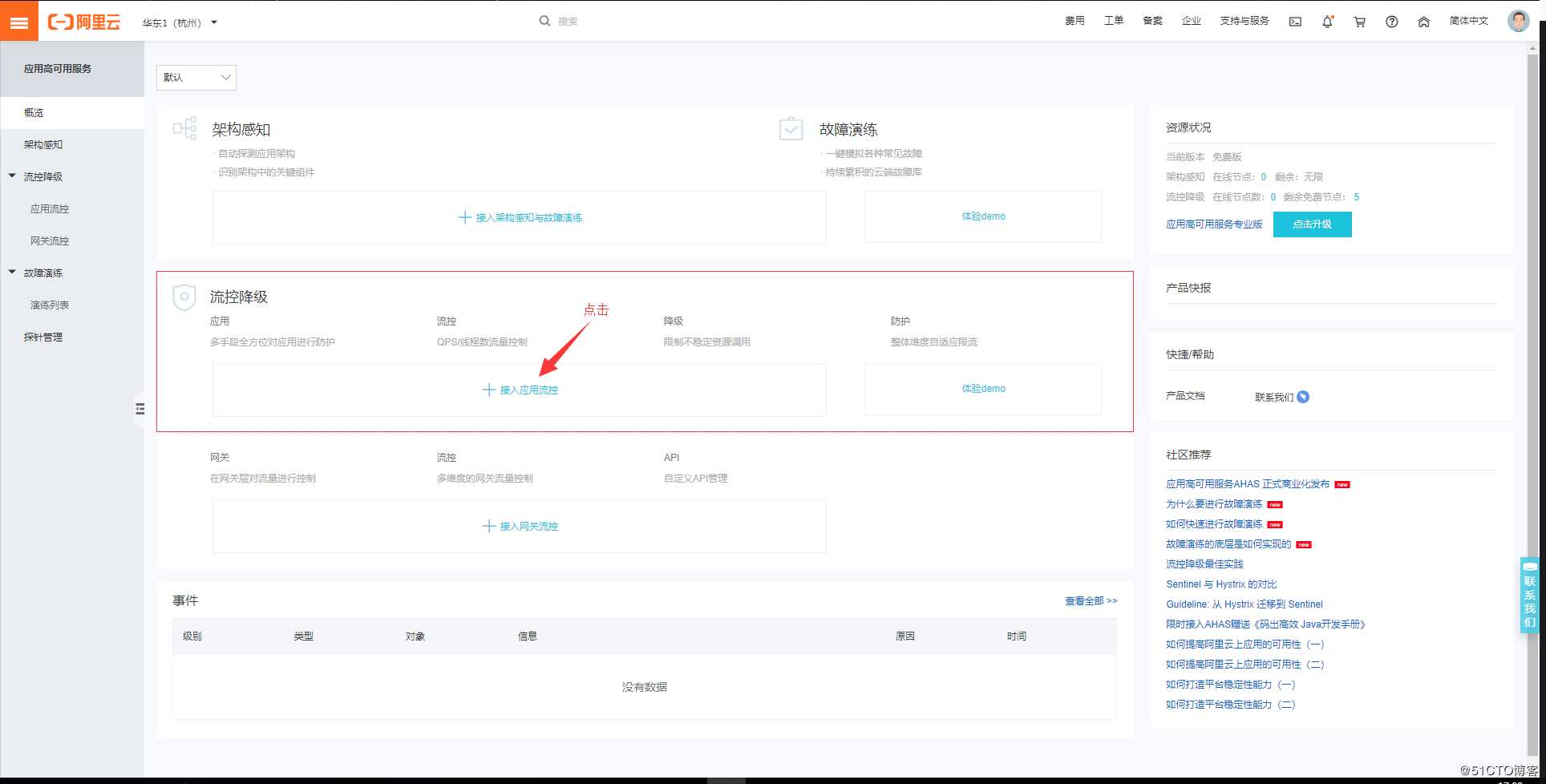
进入应用接入界面后可以选择不同的应用接入,这里按照Spring Boot应用接入的说明完成相应步骤: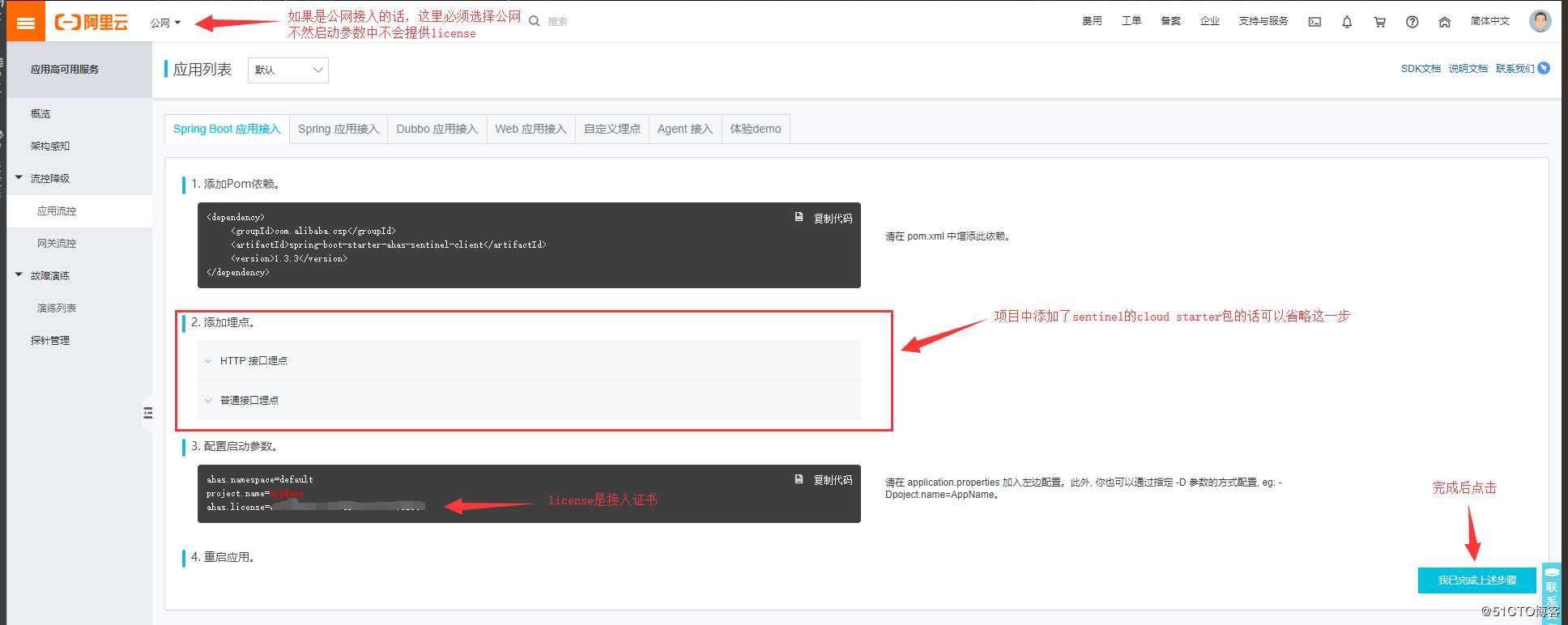
需要说明一下的是,第二步中的HTTP接口埋点和普通接口埋点都可以省略掉,因为spring-cloud-starter-alibaba-sentinel依赖包里已经实现了,但需要排除该依赖中的sentinel-transport-simple-http模块,避免连接了本地的Sentinel控制台,即修改依赖如下并添加AHAS Client依赖:
<!-- Sentinel -->
<dependency>
<groupId>org.springframework.cloud</groupId>
<artifactId>spring-cloud-starter-alibaba-sentinel</artifactId>
<!-- 排除该模块的目的是不与本地的Sentinel控制台进行通信,以免造成不必要的干扰 -->
<exclusions>
<exclusion>
<groupId>com.alibaba.csp</groupId>
<artifactId>sentinel-transport-simple-http</artifactId>
</exclusion>
</exclusions>
</dependency>
<!-- ahas client -->
<dependency>
<groupId>com.alibaba.csp</groupId>
<artifactId>spring-boot-starter-ahas-sentinel-client</artifactId>
<version>1.3.3</version>
</dependency>除了修改依赖以外,还需要将配置文件中关于Sentinel控制台的配置都注释掉,因为此时我们连接的是在线的Sentinel控制台。如下:
然后只需要添加AHAS的启动参数:
ahas:
license: xxxxxxxxx
namespace: default
project:
name: $spring.application.name完成以上步骤后,重启项目并访问该项目的接口,应用正常接入的情况下可以在阿里云的控制台中看到该应用的展示,如下:
点击该应用就可以进入到Sentinel控制台,可以看到这里基本上和我们自己搭建的Sentinel控制台是差不多的,同样支持实时监控、查看簇点链路及配置各种规则:
例如流控规则的添加也是一样的,只是界面稍微好看一点而已: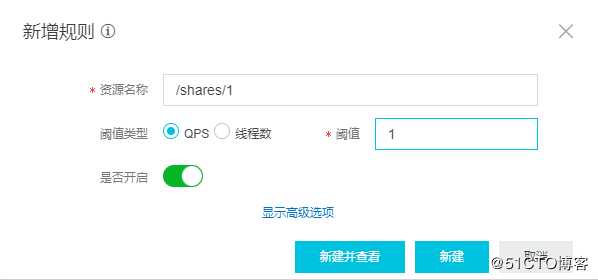
至此就完成将应用接入AHAS了,由于操作与Sentinel控制台基本一样这里就不展开介绍了,可以自行测试捣鼓一下,反正可视化的页面使用起来还是比较容易的。
以上是关于Spring Cloud Alibaba之服务容错组件 - Sentinel [规则持久化篇]的主要内容,如果未能解决你的问题,请参考以下文章